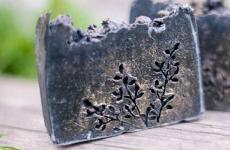What is a beard and what to do with it? Tips for beginners on threading and working on a reed loom
This is one of the richest reed weaving techniques in terms of pattern. The pattern is formed by sorting and counting the threads, which are located both at the top of the throat and at the bottom. I propose to get acquainted with this technique using the example of such a scheme:
Thread calculation:
In the Scolding 1:2 technique, there are two warp threads for one patterned thread. According to the scheme, I have 7 patterned threads, due to which we will form a pattern, which means 14 warp threads. Also, in addition to the edge, we take into account 2 edge threads, which will be located along the very edges. On the threading diagram, it will look like this:
Now we count the threads:
White thread - 16
Black thread - 6
Red threads - 7
I want to say separately about the edge (not to be confused with "edge threads") - it can be of any width and consist of a different number of threads. In my example, the edge consists of three black threads, but it can just as well be two, four, five, etc. consecutive threads of the same or different colors.
Preliminary preparation:
1. Cut the threads of the desired length.
2. Now you need to properly thread the threads. We start as always from the center. For one patterned thread, we have two warp threads - to the right and left of the patterned thread.

3. In the same way, we thread other threads symmetrically. Do not forget that for the second patterned we also have two warp threads. You can remember it like this: (base, patterned, base), (base, patterned, base), etc.

4. Here we have threaded our main pattern threads along with the warp. We carefully double-check so that nothing is lost or missed anywhere.

5. As I said, you can make the edge threads more or less in quantity, for example, two black threads per edge.

But in my example, I use three black threads, and this is what the dressing looks like at the end.

6. After filling all the threads, we tie them into a common bundle, fasten them to a fixed support and straighten the threads along the entire length.
7. We pull the threads well and tie them into a bundle. Instead of a belt, you can use a brace, which we fasten with a braid or a narrow belt at the waist. I didn’t have a staple at that time, and I adapted just such a bar with two studs along the edges. The staple is very useful when weaving, because when tying the woven part on the belt, the tension of the threads and the fabric itself are slightly distorted, and if this was not noticeable in previous techniques, then when weaving a swear pattern in this technique, the distortion can be very noticeable, especially when weaving wide belts or braid.

8. The weft thread is usually the same color as the warp, that is, in our case, the thread is white.
Weaving technique:
Step 1. At the very beginning, to get a smooth edge, you can put a ruler.

Step 2. At the very beginning of work, we simply fasten the threads, laying several rows without busting.

We should get such a chessboard.

Step 3. Next, we begin to weave the pattern. To do this, we start weaving from the row where we have 1 and 7 patterned threads at the top. In my case, this is the 2nd row according to the threading pattern. Since according to the scheme we need only 1 and 7 threads, we omit the rest. We work only with patterned threads! We do not touch the base, we have it in the background. We lay ducks, change the pharynx and knock out the threads.
Reed weaving tutorial for beginners, ready and available on the Craftika website! Making it was a very exciting experience, and I hope the audience will enjoy it, because we tried so hard! This is the first training course for me, so do not judge strictly, and I, in turn, am ready to help students in every possible way.
And now the details of the creation and content ...
What is the course about and what will it teach?
In the course you will learn:
- what is a reed and what tools are needed for weaving on it
- what materials to choose for different purposes
- how to weave and thread the warp threads in a reed
- how to weave with the simplest weaves: plain, twill and openwork
- what additional materials can be used in weaving
- how to create different effects and textures on the surface of a woven fabric
- some techniques and devices that simplify the process of weaving
- how to decorate the finished canvas
- what products can be created in this way
- how to take care of these products
What are the benefits of Crafting courses?
- unlimited access to the purchased course
- Opportunity to learn at your own pace
- feedback from the teacher, that is, with me :)
- Additional materials are included with the course.
How did it happen?
In November 2015, the guys from Kraftika contacted me and offered to develop a video course on reed weaving together. I immediately liked the idea, because I had long dreamed of making master classes in video format, but did not have such an opportunity: no suitable equipment, no mixing and processing skills, no assistant, at worst. So I immediately agreed and began to think through the structure and content of the course.
And so, in December, we started filming. I brought a bunch of yarn, scarves, and patterns into the studio, piling up the table and shelves, and making the location feel like my own home. workshop. Of course, on the first day I was terribly shy of the camera, because I had never filmed: my face was brick, my voice was quiet and strict, my eyes were bitchy ... my forehead was shiny!
But the guys were patient, we did a lot of takes until I collapsed under the table from overexertion (I never thought it would be so hard). Sometimes it felt like I was doing a specific movie: “Push your hair out of your face! Powder your forehead! Smile so that everyone can see that you are enjoying the process! Louder! It was fun as you can imagine :)
And so a few days of filming turned into a two-hour course and two two-minute promo videos. We shot the last one in the most comfortable Dial on Nevsky, namely in the far red room - I really liked it there.
Despite the fact that I'm used to performing in front of an audience and watching my speech, the camera turned out to be a real test for my nerves. Is it true, I look and talk to her, as if she had cornered me?)) I hope that I didn’t blurt out nonsense from excitement and didn’t forget everywhere, but forgive Nick, she tried very hard to do everything in the best way :)
Together we created a colorful material that illustrates in detail everything a beginner needs to learn. The technology of weaving a canvas on a reed is extremely simple, you just need to follow some rules and be attentive to details - all this in a two-hour concentrated master class that teaches everything that you can see in my products!
And now some photos highlighting the workflow :)
 First we prepare the threads. The length of the threads should be equal to the length of the belt and 0.5 m from each end on the brush. The number of threads is calculated as follows: for each thread of the pattern (red thread) there are two threads of the main color (white thread) plus two extreme threads. In addition, the belt is often bordered by an edge. In this belt, 4 white, 4 red and again 4 white threads are added in a row on each side. This can be seen in the photo.
First we prepare the threads. The length of the threads should be equal to the length of the belt and 0.5 m from each end on the brush. The number of threads is calculated as follows: for each thread of the pattern (red thread) there are two threads of the main color (white thread) plus two extreme threads. In addition, the belt is often bordered by an edge. In this belt, 4 white, 4 red and again 4 white threads are added in a row on each side. This can be seen in the photo.
 Each longitudinal bar of the reed has a hole for the thread. Thread from the middle to the edge, keeping in mind that one slit (and hole) is for one thread only.
Each longitudinal bar of the reed has a hole for the thread. Thread from the middle to the edge, keeping in mind that one slit (and hole) is for one thread only.
So, thread 55 threads into the reed for the main pattern, alternating one red thread of the pattern with two white ones - the base, and 12 each - along the edges, for a decorative edge.
 Tie the bundles of threads at the ends into knots and pull the belt blank, securing one end to a solid base (for example, on the wall) and tying the other (working) to the belt. Weave several rows to secure the threads.
Tie the bundles of threads at the ends into knots and pull the belt blank, securing one end to a solid base (for example, on the wall) and tying the other (working) to the belt. Weave several rows to secure the threads.
 First, lower the reed down - they will be divided into two streams - even and odd threads, a shed will form, and lay the weft thread (white ball) between the planes of the threads. Most often, the color of the weft is matched to the color of the main threads, and, accordingly, the extreme threads in the edge should also be of the same white color.
First, lower the reed down - they will be divided into two streams - even and odd threads, a shed will form, and lay the weft thread (white ball) between the planes of the threads. Most often, the color of the weft is matched to the color of the main threads, and, accordingly, the extreme threads in the edge should also be of the same white color.
Raise the reed up - the streams of threads will intertwine.
 "Knock" them with your palm (or better with a wooden ruler) to the beginning of weaving and tighten the weft thread so that the loop disappears. Pass the weft thread again between the layers of threads.
"Knock" them with your palm (or better with a wooden ruler) to the beginning of weaving and tighten the weft thread so that the loop disappears. Pass the weft thread again between the layers of threads.
 Change the position of the reed (down) and again "knock" the weave. Make several of these rows, weaving 5-6 cm of a "chess", fixing pattern. The denser the padding, the clearer the pattern will be; with a weak padding, the pattern will stretch along the base.
Change the position of the reed (down) and again "knock" the weave. Make several of these rows, weaving 5-6 cm of a "chess", fixing pattern. The denser the padding, the clearer the pattern will be; with a weak padding, the pattern will stretch along the base.

Start weaving according to the above pattern, guided by the following symbols: those threads that need to be picked up are marked with checkmarks; omit - with strokes; the rest - edge threads, remain in place.
 The photo shows how the penultimate thread rises (the cell marked with a checkmark) - from the lower layer to the upper one when selecting the pattern of the 13th row. When weaving, remember that now the patterned threads are between every two warp threads. And if there is no red thread between the white threads, then it is already considered to be lying below.
The photo shows how the penultimate thread rises (the cell marked with a checkmark) - from the lower layer to the upper one when selecting the pattern of the 13th row. When weaving, remember that now the patterned threads are between every two warp threads. And if there is no red thread between the white threads, then it is already considered to be lying below.
 Next, lay the weft thread between the layers of threads sorted according to the pattern. The concept of "martial belt" comes just from the fact that the pattern needs to be chosen.
Next, lay the weft thread between the layers of threads sorted according to the pattern. The concept of "martial belt" comes just from the fact that the pattern needs to be chosen.
Change the position of the reed by creating a weave of threads.
Continue weaving according to the pattern, maintaining the same density of weaving, carefully monitor the edges of the belt - they like to "worry" and do not allow the threads to sag from the wrong side. Sometimes the patterned threads will even have to be tightened, as they are used less when weaving.

The thickness of the belt depends on how thick the thread you choose. The thicker it is, the thicker and wider the belt will be. You can combine threads of different textures and thicknesses, using two threads of the desired color, if desired, instead of one thick one. Just remember: the patterned threads should be at least as thick as the main threads, and thicker is better. Thin threads will not "merge" into a pattern.
It is a little more difficult to work with woolen threads - they "twist" in the process of work, but this disadvantage is compensated by the fact that on the finished product, compared to others - from threads with cotton and viscose - the pattern is more voluminous and textured.
Another way to fill the reed can be found in the article
Many of our customers after receiving the order, the question arises: "Where to start?". I will try to answer this and several other questions.
For starters, I recommend watching our selection video on weaving on machines of this type. Here you will find detailed filling video and the beginning of weaving from different masters, and you will also see various weaving techniques and get new ideas for your future products.
Before you start to scurry basis for your first woven product, you need to understand whether the selected thread is suitable for the warp of the fabric: you need to test it for strength. If the thread breaks easily, spreads in the hands, stretches a lot, or fluff comes out of it - this thread can only be used in the weft of the product. Good for base durable And not fluffy threads of good twist, it is easier to work with them. Very thin and slippery threads are best left for later, when you gain experience, and learn how to weave evenly and beautifully from undemanding threads.
IMPORTANT POINT: For the first work, I advise you to take a blended or woolen yarn of medium thickness. Such threads are slightly stretched, springy and this compensates for the flaws of filling. Inextensible cotton, linen and other similar threads are best left for later work when you gain experience in warp warping and weaving.
At winding the warp lay on the shaft every 3-5 cm between the turns of the warp threads rigid cardboard strips 1-2 cm wide, with them the threads will be wound more evenly, and sag less.
When changing the warp thread, make sure the threads are tied in a tight, non-slip knot.
When changing weft threads the ends of the threads are not connected to each other, but overlap each other by about 3-4 cm. Protruding ends, if any, out to one side work, top or bottom. The side with the ends of the threads sticking out will subsequently be the wrong side. When weaving with a large number of different wefts, it can be convenient to bring the ends of the threads to the upper side of the work, then the lower side will be the front.
IMPORTANT POINT: If you are going to learn a new technique that is not very clear to you (for example, learning to weave on a loom with two reeds), or trying new threads for weaving, when the result is unknown - do not thread the warp to the full width of the reed at once! You will spend a lot of time, thread and effort, and the result will be unpredictable, because it is possible that the training sample will have to be refilled several times. I strongly recommend that you first thread a small base about 10 cm wide from the remnants of the threads, identify the nuances that arise in the work, work out the technique, and only after that, confidently, taking into account all the features of the work, proceed to the intended large product. This will save you time and effort, and will allow you to weave exactly what you have in mind!
We wish you beautiful work and pleasant weaving!
Weaving on a reed (educational manual)
Author - O.Yu. Skvortsova (Researcher of the Research Centertraditional culture of the Kuban State National Technical University "Kuban Cossack Choir")
2012
Berdyshko
"Berdyshko" / "Berdychka" is a wooden plank,measuring approximately 15x20 cm, in which
there are longitudinal slots 1.5–2 mm wide,
which divide the plank into "cracks", with a width
approximately 4-6 mm. Between each of them
there is a round hole with a diameter of 1.5-2 mm.
Additional tools and accessories
Additionaltools and
devices for
weaving on the "berdyshka"
are:
1- "shuttle", for weft
threads
2 - "picker" / or "knife",
for weft thread
3 - "navoi", fixture
for winding finished
products.
Consumable calculation
Belts are best learned to weave from twisted woolen(semi-woolen), cotton threads 3-5 mm
thickness, if the thread is thin, it is better to fold it in half.
For weft, you can use a thread thinner than on
base, and less strong.
The length of the threads is calculated by the formula:
finished product length + 20% + 60 cm:
20% will be spent on reducing the length of the threads following
wave-like behind the weft thread, 60 cm will go to knots with
both sides and the freedom of movement of the “berdychka”.
For example, if you need a belt 100 cm long, then
you need to take 100 cm + 20 cm + 60 cm = 180 cm of threads.
Threading the warp threads
The warp threads are alternately threaded into the holes:one thread into the slot, the other into a round hole
between slots.
Threading should always start from the middle,
distributing symmetrically from the center.
weft thread
Before starting work, the weft thread must bewind on the shuttle.
For convenience in work, the length of the shuttle should
be a few centimeters larger
product width.
Preparation for work
Further, on one side, all the warp threads are firmlybandaged and attached to something immovable and stable.
To check uniform tension
foundations and prevent tangling
it is necessary to draw a “reed” back and forth along the tucked threads
On the other hand, the threads are also tied
tight knot and fixed on the belt of the master
using a special device
"navoi" or a strong belt.
Sequence of work
The warp threads should be equally well stretched.The master controls the tension of the warp threads in
work process
Sequence of work
If we raise the bardyshkoup, then the warp threads in
round holes
are moving up.
Between warp threads
we lay the weft thread.
Then a reed with a hand
we drop down. All threads
threaded in longitudinal
slots, rise
up and the threads in round
holes remain at the bottom.
Between top and
lower threads again
we carry out a weft
(transverse) thread.
Thus, moving the “berdyshko” with your hand up
and down, we alternately raise two groups of threads
warps that are "interrupted" by weft thread and
form a weave.
Sequence of work (plain weave)
After each "passage" of the shuttle with weft threadwe nail it (thread) with a sling to the edge of the woven
products.
Variants of the simplest (filling) ornaments
Schemes of the simplest filling stations (ornaments)
Variants of products made on a reed
Belts. Cursing 1/1 or semi-cursing way.Variants of products made on a reed
Scolding 1/2. brazen waythe Baltic States
Seto Estonians,Pskov province,
Pechersky district
1st floor 19th century
the Baltic States
Girl's suitfestive. Livonian
lips. Barat II half. 19th century
Latvians. Belts
Russian Ethnographic Museum (St. Petersburg)
Komi
Komi-ZyriansKomi-Permyaks
Russian Ethnographic Museum (St. Petersburg)
Novosibirsk/Moksha
Novosibirsk Museum of Local LoreKrasnoyarsk/Russians
Regional Museum of Local Lore (Krasnoyarsk)Russians
Russian northRussian
ethnographic
museum (St. Petersburg)
Old Believers (Lipovans)
Field materials. Primorsko-Akhtarsky district. Isl. Lyashchenko M.Schemes of swear patterns (scold ½).
Thread calculation
Belt. Scolding 1/2. for 7 patterned threads.Calculation of threads 7 x 2 = 14 + 2 = 16 - background.
Further edging and filling pattern.
Broken weaving on a reed
Ornament for 5patterned threads
Thread calculation
5x2+2=12 background
Broken weaving on a reed
Belt. Scolding 1/2.for 7 patterned threads.
Calculation of threads 7 x 2
= 14 + 2 = 16 –
background.
Branoe weaving on a reed 1/2.
Refueling a bird for swearingmethod 1/2 is performed as follows
way: to one patterned thread on both sides
run two background.
Branoe weaving on a reed 1/2.
Getting started - doing a simpleplain weave.
The result is a filling pattern -
"checkers", "grains".
Branoe weaving on a reed 1/2.
Participate in the workonly patterned threads
Patterned according to the scheme
thread or raise
or omit
After
implemented
enumeration
throw
weft thread Osipova E.I. Hand weaving and weaving
belts and braids. Novgorod, 1996
Egyptian weaving. A book about traditional
weaving on tablets in ancient Egypt.
(Book in French. Photos
ethnographic fabric samples,
tools).
Traditional ornament. Textile. Release
1.2. Author-compiler O.B. Voronchikhin.
Ekaterinburg. Sverdlovsk regional house
folklore. 1998
Marina Kachaeva. Treasures of the Russian
ornament.
Tetyutskaya L.V. Weaving belts on a thread
(bastard). Toolkit. -
Novosibirsk: Knizhitsa, 2004.
Sokolova V.A. Weaving of martial belts.
Educational and methodical manual for teachers and
students in grades 8-11 of general education
schools and institutions of additional
education. - St. Petersburg, 2010.
Guseva M.M. Traditions of weaving Olonetskaya
provinces of the late XIX - early XX century. Petrozavodsk, 2011.






